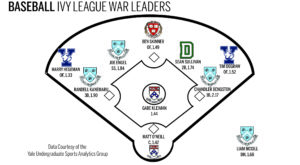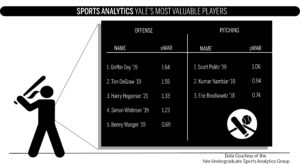

Nearly two-thirds of the way through conference play in the 2018 baseball season, Yale finds itself atop the Ivy League standings, although several teams remain within striking distance of the top two seeds — and a trip to the Ivy League Championship Series.
Enough of the season has passed to begin evaluating player statistics in hopes of offering an explanation as to why teams have or haven’t found success on the diamond this season. Looking at statistics like batting average, home runs and earned-run average (ERA) is certainly a start, but it doesn’t tell the whole story.
A better metric to use is Wins Above Replacement (WAR), a statistic that attempts to estimate how many more wins a team gains by using a given player rather than a “replacement level” player. Replacement level refers to the quantifiable skill of a bench player who might fill in for an injured starter. Typically, replacement level is considered to be below the league average for a given player, and in terms of the Ivy League, one can think of Division III as the replacement level.
There are two types of Ivy WAR that I calculated — a player’s value as a batter, called offensive WAR (oWAR) and the player’s value as a pitcher, called pitching WAR (pWAR). The main component of oWAR is called weighted on-base average (wOBA), a statistic based on the idea that doubles are more valuable than singles, but perhaps not twice as valuable. There is an additional component of oWAR that captures a player’s base-running value through their attempts to steal bases.
The driving factor behind pWAR is a metric called fielding independent pitching (FIP), a measure of pitcher skill based solely on the outcomes he can control: strikeouts, walks and home runs. I compute pWAR only for pitchers who average at least three innings per appearance, as those are the only pitchers listed on the official Ivy League baseball statistics page.
Columbia first baseman Chandler Bengston leads all Ancient Eight batters with an oWAR of 2.17. The Lions’ junior leads the league in home runs and slugging percentage by large margins and has driven in the third most runs in the league. More important, he has managed to do this while maintaining an above-average on-base percentage, something that is often a tradeoff with such raw power.
Remarkably, Columbia has four of the six most valuable hitters on its roster, with Bengston, third baseman Randell Kanemaru (1.90 oWAR, 2nd), shortstop Joe Ingell (1.84 oWAR, 4th) and utility player Liam McGill (1.67 oWAR, 6th). Perhaps then, it is no surprise that at 8–4 in Ivy play, the Lions sit just a game behind the Bulldogs in the conference standings.
Yale’s most valuable offensive weapons this season have been first baseman Griffin Dey ’19 and center fielder Tim DeGraw ’19. Dey and DeGraw’s oWAR of 1.62 and 1.52 are good for 7th and 8th in the league, respectively. While Dey is a natural-born slugger, with the second most home runs in the conference, DeGraw has yet to homer and has driven in just three runs all season. Yet the majority of DeGraw’s offensive value comes from his speed; his seven stolen bases are good for second among Ancient Eight players. DeGraw has been less prolific on the bases this year, with fewer than half his stolen base total from last season. With just six games left in the regular season, he’ll have to run wild in order to retain his oWAR crown from a season ago.
The key to success for the first-place Bulldogs this season has been their starting pitchers. All three of Yale’s primary starters are in the top-11 most valuable Ivy League pitchers. Anchored by ace Scott Politz ’19 (1.06 pWAR, 4th), Kumar Nambiar ’19 (0.94 pWAR, 5th) and a breakout season from Eric Brodkowitz ’18 (0.74 pWAR, 11th), the Bulldogs pitching staff has put up the best team ERA in the league.
It’s possible that either Politz or Nambiar could threaten for the 2018 pWAR title, but to do that, they’d have to make up ground on Penn’s Gabe Kleiman. Despite his 1–5 record, Kleiman leads the Ancient Eight with a pWAR of 1.44 ,thanks in large part to his league-best strikeout-to-walk ratio of 5.83.
With just six games to go in the regular season, it’s becoming more and more likely that Yale and Columbia will square off in the ILCS for a berth in the NCAA tournament. The potential matchup of the Lions offense versus Yale’s stellar pitching is, at least on paper, everything a fan could hope for — and may decide once and for all who the real Ivy League MVPs are.
Luke Benz is the President of the Yale Undergraduate Sports Analytics Group. Contact him at luke.benz@yale.edu .







